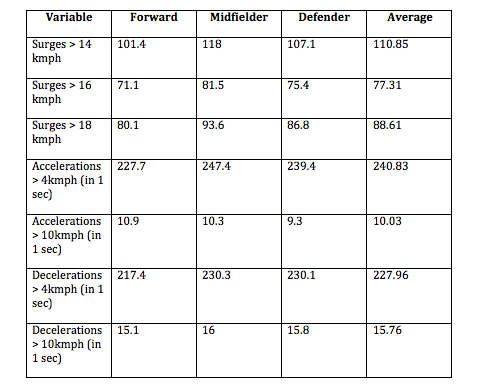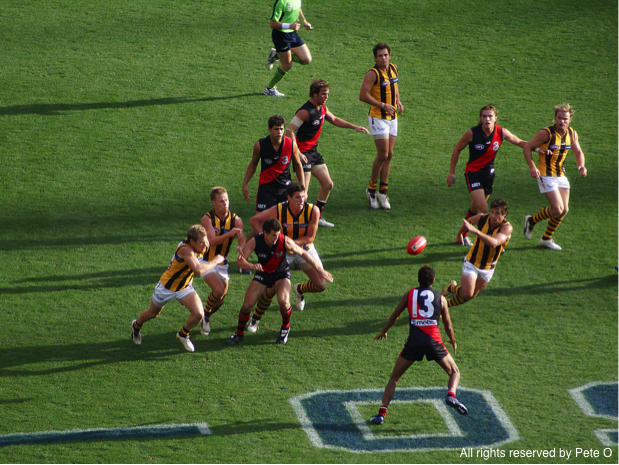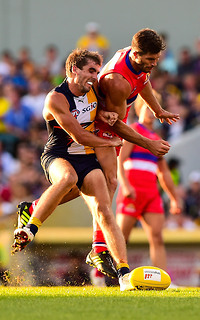Movement Demands in a Game
There are many different studies and reports out there that talk about the demands of a game of footy. However pretty much all of these are focused on the running component – and more specifically the GPS numbers, providing tables, and the numbers of sprints less than 5 meters, the number of sprints more than 20 metres, etc, etc. These are good, and indeed we delve into some of these things and explain them in more detail, as well as give links to several of these reports in Agility, Speed & Conditioning for Aussie Rules. But these sorts of reports can get a little tedious and quite ‘numbers-heavy’ and as a result don’t say a great deal to the average reader. So what we are looking at here in our demands of the game discussion, is more of a breakdown of the various physical tasks themselves, rather than numbers. This is an abbreviation of the discussion that we have in Functional Strength Training for Australian Rules Football.
 Taken from the GPS analysis discussion in Agility, Speed & Conditioning for Aussie Rules
Taken from the GPS analysis discussion in Agility, Speed & Conditioning for Aussie Rules
Leaping Ability
Double Foot Jump
Most commonly required in a ruck contest or when jumping off both feet for a mark or a tap of some sort in a stationary position. The most closely associated movement pattern here is a squat (a very powerfully executed one.) Kettlebell swings also have very similar hip mechanics to this common football requirement. Please note, leg presses will do absolutely nothing to improve your jumping ability.
Single Leg Jump
Again, commonly associated with ruck work, or jumping for a mark, although much more common when on the move or running to jump. Step-ups and step-up variations are the common movement pattern associated with such a movement. an interesting point to note is that a good double-leg vertical leap does not necessarily translate to a good single-leg vertical leap, as they are different motor programs as well as skills.
Acceleration
Or more specifically the need for acceleration power. The guys who appear to be the quickest guys out on the field aren’t necessarily the best sprinters, but rather the guys who can take off and accelerate the most powerfully. After all, sprints in footy often don’t last more than 30-40 meters, before you have to stop and change directions to adjust to how the play has unfolded (be it a turnover, or a stoppage or a general pattern change in the play.)
Deceleration
Footy is such a dynamic game, where the patterns of play can change abruptly. You may be sprinting flat out one minute, then due to a change in the play, you suddenly must stop and head in a totally different direction, or get involved in a contest of some sort. As such, efficient and well-coordinated deceleration is required, which requires a great deal of eccentric strength and power to achieve as well as to avoid soft tissue injury. This is why placing an over-emphasis on sprint training only, misses the point, as there is no deceleration component to it. Sprinters are required only to run as fast as possible in a straight line, with no deceleration or change of direction required. This certainly isn’t the case in a game of footy. So it is important to note with effective deceleration, the aim here is not only to effectively perform it, bust also for the tendons, ligaments and joint attachments to effectively absorb and cope with this loading.
This ties in greatly with deceleration, where the ability to effectively decelerate often sets you up to be able to effectively change directions. Following the deceleration, the ability to effectively and powerfully push back off in the next direction is a key movement ability in footy, when evading an opponent, or chasing an opponent, or simply trying to lose an opponent when leading.
Probably the most demanding physical task associated with footy. Running 12km at high intensity in a game is one thing, but having to physically assault (within the rules of course) an opponent, who often will weigh 90kg+ is a different ball game altogether. Then if you factor in having to perform this task repeatedly throughout a match, you would want to be able to do it well. Tackling combines several movement patterns, depending on what the situation is. It may involve more of a lunge pattern in one instance, or more of a squat and pull pattern in another. But the primary pattern that will always be present and at the core of this movement is the rotation pattern (and remember how undertrained this pattern and plane of movement is.)

Stationary Marking Contest
This is the common 1-on-1 body-to-body contest that we so often see between 2 opponents. However, there is far more to this contest than simply overpowering the opponent with a strong upper body push. There is also a great amount of balance required, core strength, and the transference of power from the ground up through the torso and finally out through the hands. Simply performing bench press will not make you better at this. It will assist, and provide the potential to get better at this. However, we add a couple crucial add-ons to the bench press to train this ability, and make it a full body exercise, just as it is a full body requirement in a match, with no bench to support you.
Ground Ball Contest on the feet
This is a very broad category and can encompass many different scenarios, however they all involve a combination of acceleration, deceleration and the changing of direction, single leg strength, core strength and stability coupled with upper body strength to hold off an opponent, as well as a degree of balance and coordination.
Core and Pelvic Stability (when kicking, jumping, running)
This again is a very broad and all encompassing requirement. ‘Core and hip stability’ isn’t overly specific, and as we have covered previously the role of certain muscle groups can change dependent on what pattern of movement or task is being performed. However, the key point here is that there is a great deal of hip stability coupled with core stability required in commonly preformed (and seemingly simple) tasks such as kicking, running and jumping.
Effectively Absorbing Hits 
Of all the footy codes, none have this ability as high up in importance as Aussie Rules. Some of the hits in the rugby codes or gridiron (albeit wearing helmets and plenty of padding) may be bigger, however in a game of Aussie Rules, you can cop this hit from any direction.
This is not just about having a bit of extra muscle mass to absorb hits and not feel the hit as much, but more so to do with having adequate stabiliser strength for absorbing hits.
Performing all these tasks with proficiency in all 3 planes of motion
We covered this point in another article, but it is a good time to touch on it again here. When training to improve for the tasks above, remember that they are performed in a dynamic environment, standing, and involving movement and stability all 3 planes of motion. Don’t fall into the old trap of performing sagittal plane dominant exercises, or even worse exercises on machines where no ability is required. If you want to improve your ability to push off an opponent in a marking contest, a seated chest press wont help one little bit, and a bench press on its own will only be marginally better. A combination of bench press, Swiss ball pressing and standing cable pressing is better – as well as combining this with work on other full body patterns like squatting. If you want to improve your ability to change directions quicker, a leg press is useless. A multi-directional lunge is the way to go.
So here is just a brief touching of all the tasks – and there are others, where if we got more technical could layout more. The point is that there is a lot of movement quality to train - and remember we had the discussion that strength training is about improving movement quality in these tasks and developing a better base for footy specific expressions of power.
It is important that the tasks and movement qualities that you are aiming to perform and improve on are specifically taken into account when performing your training program, including strength, power and running work. Without such consideration, you will minimise the effectiveness of the training you are doing, and as a result will end up seeing virtually no benefit (in football terms) for all the extra work that you are putting in.
Strength Coach

